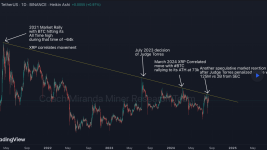Table of Contents
- Introduction
- Understanding Bitcoin's Rise and Mystique
- The Documentary Overview: "Money Electric: The Bitcoin Mystery"
- The Genesis of Bitcoin
- Satoshi Nakamoto: The Anonymous Creator
- The Whitepaper That Changed the World
- How Bitcoin Works: The Foundation of Blockchain
- Decentralized Ledger and Blockchain
- Bitcoin Mining: From Gold Rush to Energy Debate
- Bitcoin’s Impact on Global Finance
- Disrupting Traditional Banking Systems
- The Role of Bitcoin in Emerging Economies
- The Rise and Fall: Bitcoin’s Market Journey
- 2017 Boom and the Crash
- Recovery and Institutional Adoption
- Other Famous Cryptocurrencies: The Digital Revolution Beyond Bitcoin
- Ethereum: Smart Contracts and DeFi Ecosystem
- Ripple (XRP): Speedy Transfers for International Trade
- Litecoin: The Silver to Bitcoin’s Gold
- Binance Coin (BNB): The Power of Exchange Tokens
- Cardano (ADA): Third-Generation Blockchain Innovator
- Trading in the Digital World: A Beginner's Guide
- Understanding Volatility in Crypto Markets
- Day Trading vs. HODLing: Which is Right for You?
- Where to Watch "Money Electric: The Bitcoin Mystery"
- Streaming Platforms Offering the Documentary
- How to Access It Globally
- Conclusion: The Future of Bitcoin and Cryptocurrencies
- Is Bitcoin the New Digital Gold?
- Cryptocurrencies and the Evolution of Money
1. Introduction
Understanding Bitcoin's Rise and Mystique
Bitcoin has gone from being a niche technological concept to a global financial phenomenon that challenges traditional ideas of money. The documentary Money Electric: The Bitcoin Mystery offers a deep dive into how this digital currency emerged, its impact, and what lies ahead. Bitcoin’s origin is steeped in intrigue, with its anonymous creator, Satoshi Nakamoto, having left the world guessing about their identity since 2009. This air of mystery forms the backdrop for Bitcoin’s ascension to the heights of financial innovation.
2. The Genesis of Bitcoin
Satoshi Nakamoto: The Anonymous Creator
At the heart of the Bitcoin enigma is Satoshi Nakamoto, a pseudonymous entity or individual who published Bitcoin’s whitepaper in 2008. Nakamoto's disappearance in 2011 only adds to the allure of the cryptocurrency, leaving the Bitcoin community to speculate about the true identity of the person or people behind the project.


The Whitepaper That Changed the World
Satoshi Nakamoto’s whitepaper, titled “Bitcoin: A Peer-to-Peer Electronic Cash System,” laid out the blueprint for what would become a decentralized revolution. It introduced a way to perform transactions without the need for intermediaries like banks or governments. Blockchain, the underlying technology, ensured that every transaction was secure, immutable, and transparent.
Visual 1: Cover of Satoshi Nakamoto’s Bitcoin Whitepaper
Visual 1: Cover of Satoshi Nakamoto’s Bitcoin Whitepaper
3. How Bitcoin Works: The Foundation of Blockchain
Decentralized Ledger and Blockchain
The essence of Bitcoin lies in its decentralized structure. Bitcoin operates on a public ledger known as the blockchain, which records every transaction made using the cryptocurrency. The blockchain is maintained by a global network of nodes, making it highly secure and resistant to fraud.
Bitcoin Mining: From Gold Rush to Energy Debate
Bitcoin’s creation process, known as mining, involves solving complex mathematical puzzles. This process consumes a significant amount of energy, sparking debates over its environmental impact. Early miners could mine Bitcoin with home computers, but now, specialized hardware known as ASICs (Application-Specific Integrated Circuits) dominates the mining landscape.
Visual 2: Illustration of Bitcoin mining rigs in action
Visual 2: Illustration of Bitcoin mining rigs in action
4. Bitcoin’s Impact on Global Finance
Disrupting Traditional Banking Systems
Bitcoin challenges traditional banking systems by allowing people to send and receive money without intermediaries. Banks typically charge fees for international transfers, but Bitcoin transactions are cheaper and faster. Bitcoin is a game-changer for people in countries with unstable financial systems, where access to traditional banking might be limited.
The Role of Bitcoin in Emerging Economies
In countries experiencing hyperinflation or strict capital controls, Bitcoin provides a financial alternative. People in countries like Venezuela and Zimbabwe have turned to Bitcoin to preserve their wealth when their national currencies collapsed.
Visual 3: Bitcoin adoption in emerging economies map
Visual 3: Bitcoin adoption in emerging economies map
2017 Boom and the Crash
Bitcoin’s price surged in 2017, capturing global attention as it neared the $20,000 mark. However, the speculative bubble soon burst, with the cryptocurrency losing over 70% of its value within a few months. This volatility became one of the hallmarks of cryptocurrency markets, driving caution among institutional investors.
Recovery and Institutional Adoption
Despite the crash, Bitcoin bounced back. In 2020 and 2021, institutional investors like Tesla and MicroStrategy began buying Bitcoin, helping legitimize it as an asset class. With growing acceptance from large financial institutions, Bitcoin solidified its place in the global financial ecosystem.
Visual 4: Graph showing Bitcoin’s price history and major events
Visual 4: Graph showing Bitcoin’s price history and major events
6. Other Famous Cryptocurrencies: The Digital Revolution Beyond Bitcoin
While Bitcoin is the most well-known digital currency, there are thousands of others, each with unique features and value propositions. Here are some of the most significant ones:
Ethereum: Smart Contracts and DeFi Ecosystem
Ethereum is more than just a cryptocurrency; it’s a platform that allows developers to build decentralized applications (dApps) using smart contracts. Ethereum is the backbone of decentralized finance (DeFi), enabling users to borrow, lend, and trade without traditional intermediaries.
Visual 5: Ethereum logo with a visual representation of smart contracts
Visual 5: Ethereum logo with a visual representation of smart contracts
Ripple (XRP): Speedy Transfers for International Trade
Ripple focuses on enabling fast, low-cost international payments. Unlike Bitcoin, which is entirely decentralized, Ripple works with banks and financial institutions to facilitate cross-border transactions.
Litecoin: The Silver to Bitcoin’s Gold
Often referred to as Bitcoin’s little brother, Litecoin was created by Charlie Lee in 2011. It offers faster transaction times and lower fees, making it suitable for everyday purchases.
Binance Coin (BNB): The Power of Exchange Tokens
BNB was created by Binance, the world’s largest cryptocurrency exchange. Initially, BNB was used to pay for transaction fees on the exchange, but it has evolved into a versatile digital asset with numerous applications within the Binance ecosystem.
Cardano (ADA): Third-Generation Blockchain Innovator
Cardano was founded by one of Ethereum’s co-founders, Charles Hoskinson. It’s often considered a third-generation blockchain, aiming to improve upon Bitcoin and Ethereum by offering scalability, sustainability, and security.
Visual 6: Logos of Ethereum, Ripple, Litecoin, Binance Coin, and Cardano
Visual 6: Logos of Ethereum, Ripple, Litecoin, Binance Coin, and Cardano
7. Trading in the Digital World: A Beginner's Guide
Understanding Volatility in Crypto Markets
The cryptocurrency market is known for its extreme volatility, where prices can skyrocket or plummet within hours. This volatility presents both opportunities and risks for traders and investors.
Day Trading vs. HODLing: Which is Right for You?
There are different strategies for approaching cryptocurrency investments. Day traders seek to profit from short-term price movements, while "HODLers" (a term derived from a misspelled “hold”) take a long-term approach, believing that the value of cryptocurrencies will rise over time.
Visual 7: Bitcoin trading chart with buy/sell signals
Visual 7: Bitcoin trading chart with buy/sell signals
8. Where to Watch "Money Electric: The Bitcoin Mystery"
Streaming Platforms Offering the Documentary
As of the time of writing, Money Electric: The Bitcoin Mystery is available on popular streaming platforms such as Netflix, Amazon Prime, and YouTube. These platforms offer the documentary in various regions, making it accessible to a global audience interested in learning more about Bitcoin and digital currencies.
How to Access It Globally
If the documentary is not available in your region, consider using a Freebie Account's to access streaming services from other countries. Most services offer subtitles and dubbed versions in multiple languages.
9. Conclusion: The Future of Bitcoin and Cryptocurrencies
Is Bitcoin the New Digital Gold?
Bitcoin is often referred to as "digital gold" due to its finite supply and role as a store of value. As more institutional investors enter the space, Bitcoin's status as a hedge against inflation is solidifying.
Cryptocurrencies and the Evolution of Money
Beyond Bitcoin, the broader cryptocurrency market is pushing the boundaries of financial systems worldwide. As blockchain technology continues to evolve, it’s likely that digital currencies will play an increasingly central role in the global economy.
Visual 8: Illustration of a futuristic economy with Bitcoin as a major currency
Visual 8: Illustration of a futuristic economy with Bitcoin as a major currency
Final Word
Money Electric: The Bitcoin Mystery explores Bitcoin’s journey from its mysterious beginnings to its status as a major player in the world of finance. Alongside other cryptocurrencies like Ethereum and Ripple, Bitcoin is revolutionizing the way we think about money and the future of global transactions.










